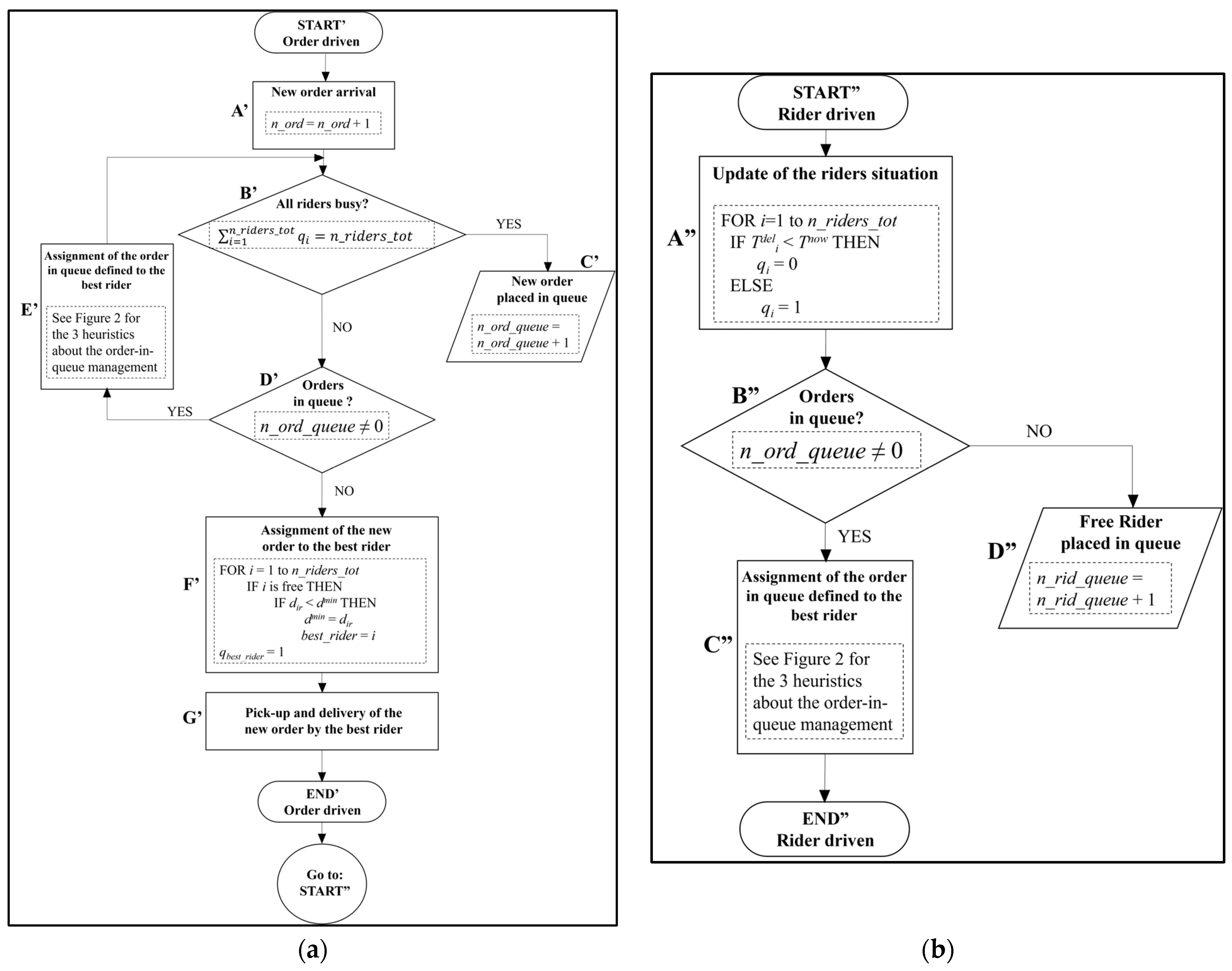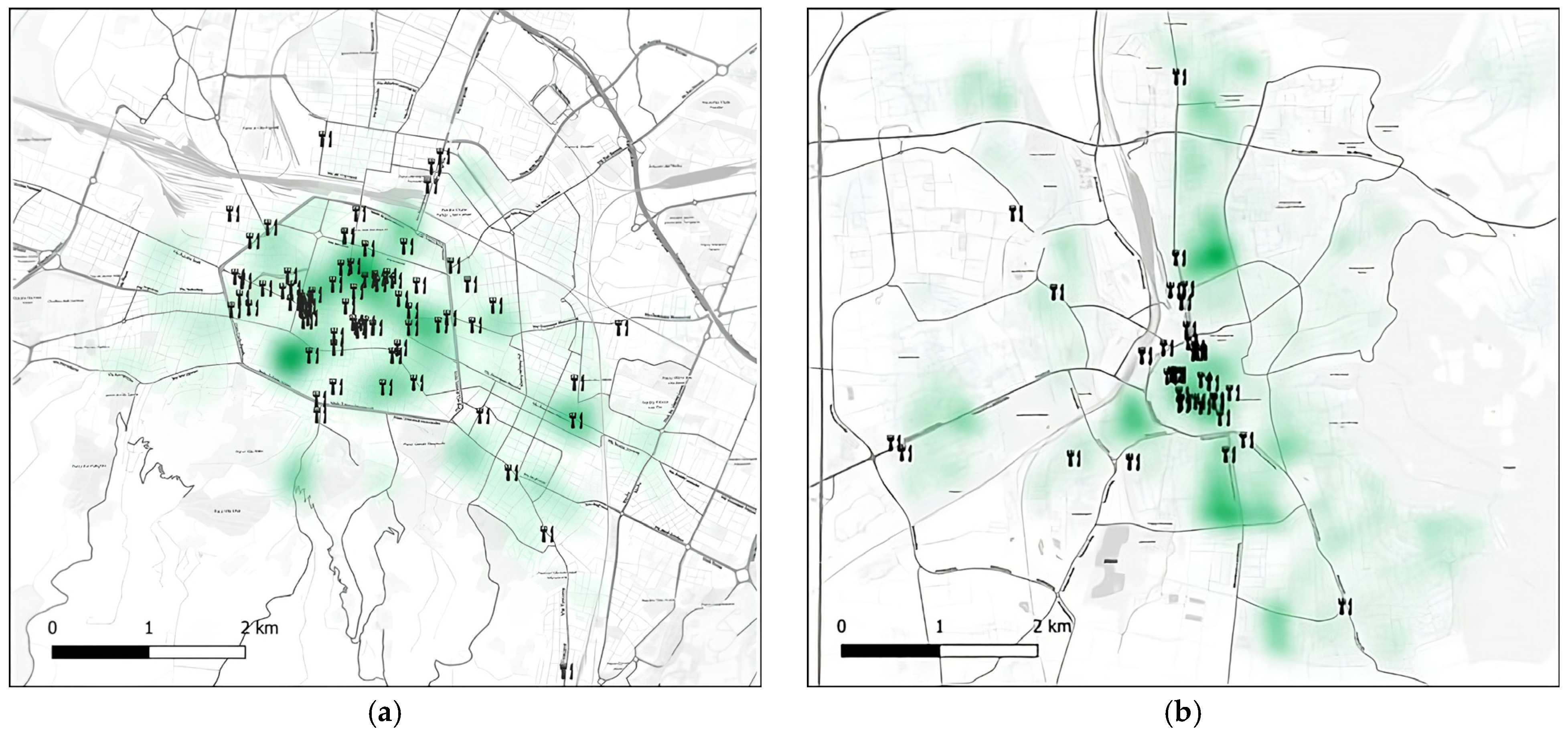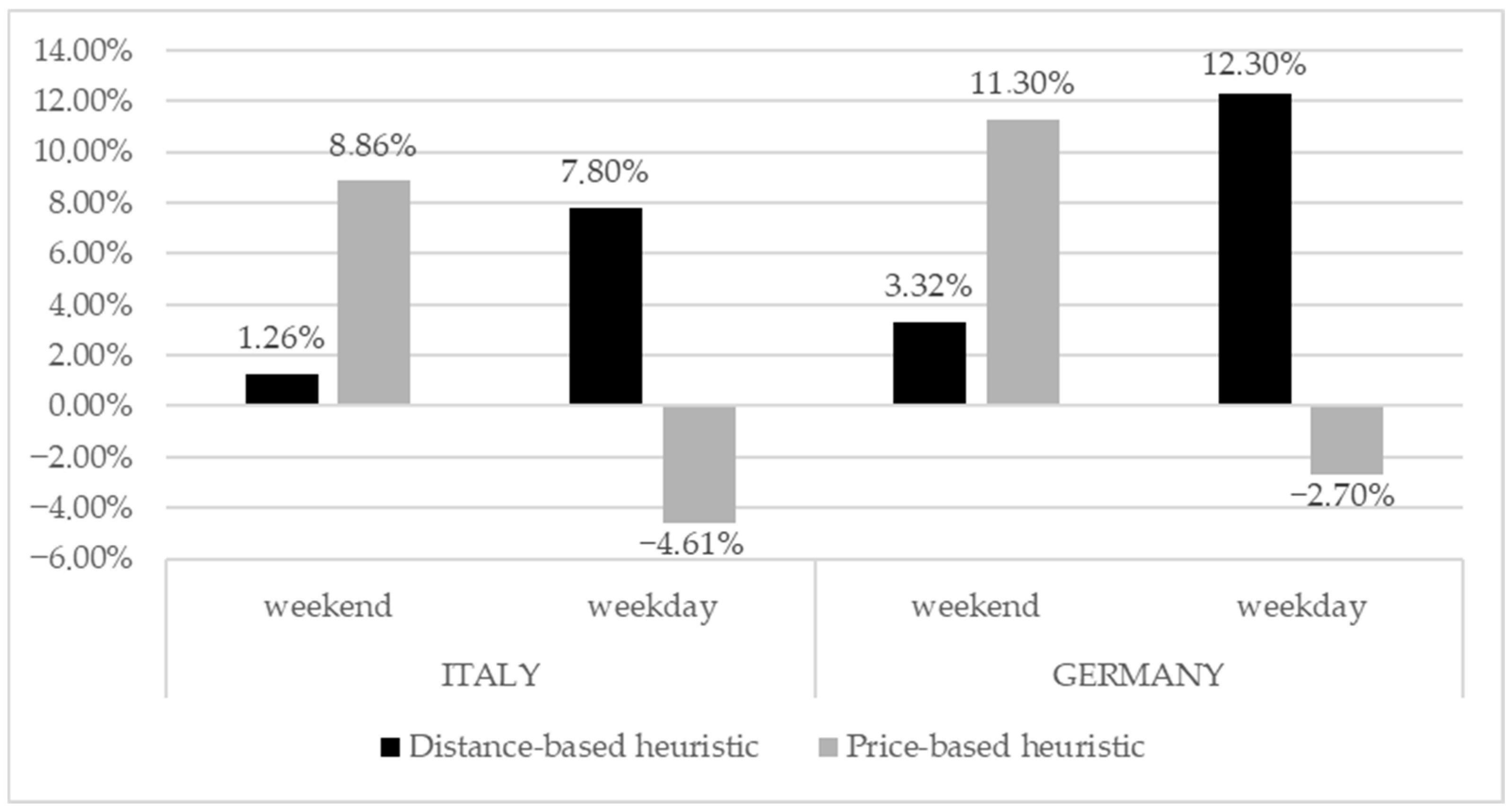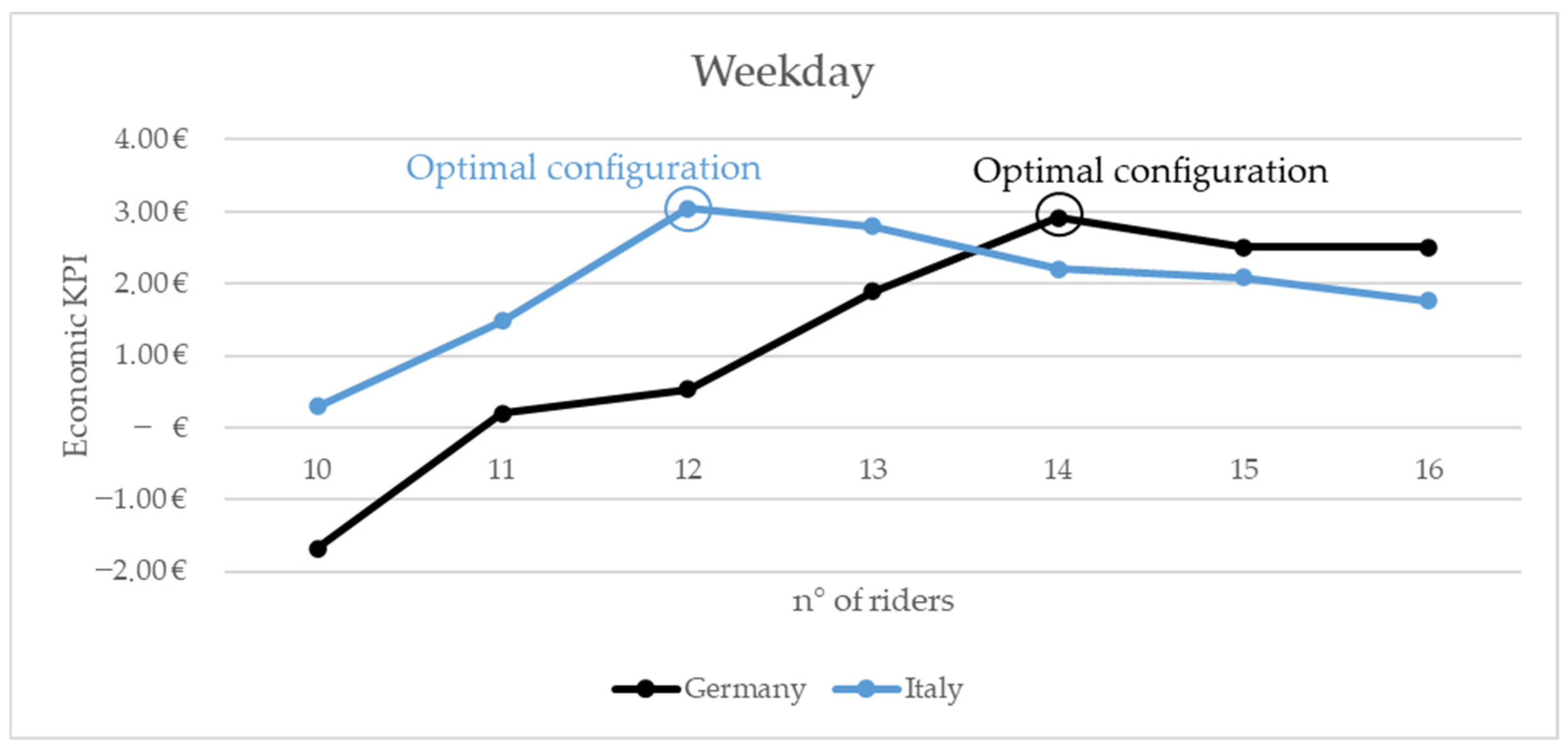Doing Good or Doing Better? Comparing Freelance and Employment Models for a Social Sustainable Food Delivery Sector
Abstract
1. Introduction
2. Literature Review
3. Materials and Methods
- Order ID;
- Number of ordered items;
- Date and time of order creation;
- Order price;
- Customer address;
- ID of the restaurant whose products are ordered;
- Restaurant address.
- Constant speed of the bike;
- Total number of riders available;
- Cost of a rider per hour (c_rider);
- Constant preparation time for the order by the restaurant;
- Number of hours per shift (n_hours);
- Time intervals: useful to define whether an order is on time or late and, if it is late, whether the delay is considered acceptable, normal, or serious.
4. Case Study
4.1. Survey Set-Up
4.2. Instances for the Quantitative Algorithm
- Td <= 45 min: order in time (no penalty for the platform)
- 45 min < Td <= 60 min: medium delay and, thus, 50% discount for the customer of the current order
- Td > 60 min: high delay and, thus, 100% discount for the customer in the current order
5. Results
5.1. Rider Survey
5.2. Heuristic Analysis
6. Conclusions
Author Contributions
Funding
Institutional Review Board Statement
Informed Consent Statement
Data Availability Statement
Acknowledgments
Conflicts of Interest
References
- Alaimo, C.; Kallinikos, J. Managing by Data: Algorithmic Categories and Organizing. Organ. Stud. 2021, 42, 1385–1407. [Google Scholar] [CrossRef]
- Chiang, Y.C.; Huang, J.; Chou, C.J. A study on the business model of food delivery platform. Int. J. Organ. Innov. 2024, 16, 125–141. [Google Scholar]
- Suguna, M.; Shah, B.; Raj, S.K.; Suresh, M. A Study on the Influential Factors of the Last Mile Delivery Projects during COVID-19 Era. Oper. Manag. Res. 2022, 15, 399–412. [Google Scholar] [CrossRef]
- Poon, W.C.; Tung, S.E.H. The Rise of Online Food Delivery Culture during the COVID-19 Pandemic: An Analysis of Intention and Its Associated Risk. Eur. J. Manag. Bus. Econ. 2024, 33, 54–73. [Google Scholar] [CrossRef]
- Collignon, S.E.; Sternberg, H.S. Adoption of Multiple Electronic Marketplaces: Antecedents from a Grounded Theory Study. J. Bus. Logist. 2020, 41, 310–333. [Google Scholar] [CrossRef]
- Ulmer, M.W.; Thomas, B.W.; Campbell, A.M.; Woyak, N. The Restaurant Meal Delivery Problem: Dynamic Pickup and Delivery with Deadlines and Random Ready Times. Transp. Sci. 2021, 55, 75–100. [Google Scholar] [CrossRef]
- Tassinari, A.; Maccarrone, V. Riders on the Storm: Workplace Solidarity among Gig Economy Couriers in Italy and the UK. Work. Employ. Soc. 2020, 34, 35–54. [Google Scholar] [CrossRef]
- Davis-Sramek, B.; Richey, R.G. Logistics for a Better World. J. Bus. Logist. 2022, 43, 294–296. [Google Scholar] [CrossRef]
- Chen, X.; Wu, S.; Shi, C.; Huang, Y.; Yang, Y.; Ke, R.; Zhao, J. Sensing Data Supported Traffic Flow Prediction via Denoising Schemes and ANN: A Comparison. IEEE Sens. J. 2020, 20, 14317–14328. [Google Scholar] [CrossRef]
- Wang, Q.; Churchill, B. Risky Business: How Food-Delivery Platform Riders Understand and Manage Safety at Work. J. Sociol. 2025, 61, 291–307. [Google Scholar] [CrossRef]
- Hildebrandt, F.D.; Ulmer, M.W. Supervised Learning for Arrival Time Estimations in Restaurant Meal Delivery. Transp. Sci. 2022, 56, 1058–1084. [Google Scholar] [CrossRef]
- Peng, L.; Shui, S.; Li, Z.; Yang, J. Food Delivery Couriers and Their Interaction with Urban Public Space: A Case Study of a Typical “Takeaway Community” in the Wuhan Optics Valley Area. Sustainability 2022, 14, 6238. [Google Scholar] [CrossRef]
- Lin, P.M.C.; Au, W.C.; Leung, V.T.Y.; Peng, K.-L. Exploring the Meaning of Work within the Sharing Economy: A Case of Food-Delivery Workers. Int. J. Hosp. Manag. 2020, 91, 102686. [Google Scholar] [CrossRef]
- Leschke, J.; Scheele, L. Predictability and Transparency of Working Conditions for Food Delivery Platform Workers across Selected EU Countries. Soc. Policy Adm. 2024, 58, 638–657. [Google Scholar] [CrossRef]
- Van Yperen, N.W.; Wörtler, B.; De Jonge, K.M.M. Workers’ Intrinsic Work Motivation When Job Demands Are High: The Role of Need for Autonomy and Perceived Opportunity for Blended Working. Comput. Hum. Behav. 2016, 60, 179–184. [Google Scholar] [CrossRef]
- Borghetti, F.; Caballini, C.; Carboni, A.; Grossato, G.; Maja, R.; Barabino, B. The Use of Drones for Last-Mile Delivery: A Numerical Case Study in Milan, Italy. Sustainability 2022, 14, 1766. [Google Scholar] [CrossRef]
- Galkin, A.; Obolentseva, L.; Balandina, I.; Kush, E.; Karpenko, V.; Bajdor, P. Last-Mile Delivery for Consumer Driven Logistics. Transp. Res. Procedia 2019, 39, 74–83. [Google Scholar] [CrossRef]
- Pilati, F.; Tronconi, R. Tri-Objective Vehicle Routing Problem to Optimize the Distribution Process of Sustainable Local E-Commerce Platforms. Sustainability 2024, 16, 1810. [Google Scholar] [CrossRef]
- Toth, P.; Vigo, D. (Eds.) Vehicle Routing: Problems, Methods, and Applications, 2nd ed.; MOS-SIAM series on optimization; Society for Industrial and Applied Mathematics: Philadelphia, PA, USA, 2014; ISBN 978-1-61197-358-7. [Google Scholar]
- Zheng, T.; Grosse, E.H.; Morana, S.; Glock, C.H. A Review of Digital Assistants in Production and Logistics: Applications, Benefits, and Challenges. Int. J. Prod. Res. 2024, 62, 8022–8048. [Google Scholar] [CrossRef]
- Liu, X.; Qiu, L.; Fang, Y.; Wang, K.; Li, Y.; Rodríguez, J. Event-Driven Based Reinforcement Learning Predictive Controller Design for Three-Phase NPC Converters Using Online Approximators. IEEE Trans. Power Electron. 2025, 40, 4914–4926. [Google Scholar] [CrossRef]
- Xu, H.; Qian, W.; Guo, K.; Wang, X. Research on Takeaway Delivery Route Optimization Problem Considering Merchant Priority. Sustainability 2024, 16, 11127. [Google Scholar] [CrossRef]
- Rajabi-Bahaabadi, M.; Shariat-Mohaymany, A.; Babaei, M.; Vigo, D. Reliable Vehicle Routing Problem in Stochastic Networks with Correlated Travel Times. Oper. Res. Int. J. 2021, 21, 299–330. [Google Scholar] [CrossRef]
- Dai, H.; Tao, J.; Jiang, H.; Chen, W. O2O On-Demand Delivery Optimization with Mixed Driver Forces. IFAC-PapersOnLine 2019, 52, 391–396. [Google Scholar] [CrossRef]
- Geissinger, A.; Laurell, C.; Öberg, C.; Sandström, C. How Sustainable Is the Sharing Economy? on the Sustainability Connotations of Sharing Economy Platforms. J. Clean. Prod. 2019, 206, 419–429. [Google Scholar] [CrossRef]
- Lehdonvirta, V.; Kässi, O.; Hjorth, I.; Barnard, H.; Graham, M. The Global Platform Economy: A New Offshoring Institution Enabling Emerging-Economy Microproviders. J. Manag. 2018, 45, 567–599. [Google Scholar] [CrossRef] [PubMed]
- Gao, L.; Zhan, M. Route Optimization of Multimodal Transport Considering Regional Differences under Carbon Tax Policy. Sustainability 2025, 17, 5743. [Google Scholar] [CrossRef]
- Fabo, B.; Karanovic, J.; Dukova, K. In Search of an Adequate European Policy Response to the Platform Economy. Transf. Eur. Rev. Labour Res. 2017, 23, 163–175. [Google Scholar] [CrossRef]
- Huang, N.; Burtch, G.; Hong, Y.; Pavlou, P.A. Unemployment and Worker Participation in the Gig Economy: Evidence from an Online Labor Market. Inf. Syst. Res. 2020, 31, 431–448. [Google Scholar] [CrossRef]
- Li, C.; Mirosa, M.; Bremer, P. Review of Online Food Delivery Platforms and Their Impacts on Sustainability. Sustainability 2020, 12, 5528. [Google Scholar] [CrossRef]
- Muszyński, K.; Pulignano, V.; Marà, C. Product Markets and Working Conditions on International and Regional Food Delivery Platforms: A Study in Poland and Italy. Eur. J. Ind. Relat. 2022, 28, 295–316. [Google Scholar] [CrossRef]
- Rauch, E.; Linder, C.; Dallasega, P. Anthropocentric Perspective of Production before and within Industry 4.0. Comput. Ind. Eng. 2020, 139, 105644. [Google Scholar] [CrossRef]
- Robijn, W.; Euwema, M.C.; Schaufeli, W.B.; Deprez, J. Leaders, Teams and Work Engagement: A Basic Needs Perspective. Career Dev. Int. 2020, 25, 373–388. [Google Scholar] [CrossRef]
- Rich, B.L.; Lepine, J.A.; Crawford, E.R. Job Engagement: Antecedents and Effects on Job Performance. Acad. Manag. J. 2010, 53, 617–635. [Google Scholar] [CrossRef]
- Junge, A.L.; Straube, F. Sustainable Supply Chains—Digital Transformation Technologies’ Impact on the Social and Environmental Dimension. Procedia Manuf. 2020, 43, 736–742. [Google Scholar] [CrossRef]
- Hu, Q.; Lu, Y.; Pan, Z.; Gong, Y.; Yang, Z. Can AI Artifacts Influence Human Cognition? The Effects of Artificial Autonomy in Intelligent Personal Assistants. Int. J. Inf. Manag. 2021, 56, 102250. [Google Scholar] [CrossRef]
- Cirillo, V.; Rinaldini, M.; Staccioli, J.; Virgillito, M.E. Technology vs. Workers: The Case of Italy’s Industry 4.0 Factories. Struct. Change Econ. Dyn. 2021, 56, 166–183. [Google Scholar] [CrossRef]
- Wallenburg, C.M.; Johne, D.; Cichosz, M.; Goldsby, T.J.; Knemeyer, A.M. Alignment Mechanisms for Supplier-Initiated Innovation: Results from the Logistics Service Industry. J. Purch. Supply Manag. 2019, 25, 100575. [Google Scholar] [CrossRef]
- Schedlinsky, I.; Schmidt, M.; Wöhrmann, A. Interaction of Information and Control Systems: How the Perception of Behavior Control Affects the Motivational Effect of Relative Performance Information. Account. Organ. Soc. 2020, 86, 101171. [Google Scholar] [CrossRef]
- McKinsey&Company. The Two-Wheeled Commute: Micromobility and Your Future. Available online: https://www.mckinsey.com/industries/automotive-and-assembly/our-insights/the-two-wheeled-commute-micromobility-and-your-future (accessed on 6 September 2025).
- Hartmann, V.; Schuhmacher, D. Semi-Discrete Optimal Transport: A Solution Procedure for the Unsquared Euclidean Distance Case. Math. Methods Oper. Res. 2020, 92, 133–163. [Google Scholar] [CrossRef]
- PwC Legal. Gig Economy 2021. Available online: https://www.pwclegal.be/en/FY21/gig-economy-report-v3-2021.pdf (accessed on 2 September 2025).
- Klarin, A.; Suseno, Y. A State-of-the-Art Review of the Sharing Economy: Scientometric Mapping of the Scholarship. J. Bus. Res. 2021, 126, 250–262. [Google Scholar] [CrossRef]






| Parameter | Definition |
|---|---|
| n_ord | Total number of orders |
| n_riders_tot | Total number of riders employed |
| n_rest_tot | Total number of restaurants |
| i | Rider (from 1 to n_riders_tot) |
| r | Restaurant (from 1 to n_rest_tot) |
| qi | Binary variable related to each rider i: 1 if rider i is busy 0 if rider i is idle |
| n_ord_queue | Number of orders in the queue |
| n_rid_queue | Number of idle riders waiting for a new order to arrive |
| dmin | Minimum distance rider–restaurant (initialized to a high value) |
| di,r | Distance between rider i and restaurant r of the new order |
| best_rider | Rider that minimizes the distance to the restaurant |
| Tnow | Current time of the day |
| Tdeli | Time of the delivery of the current order of rider i |
| Parameter | Definition |
|---|---|
| o | Order (from 1 to n_ord) |
| Tmin | Minimum order creation time (initialized to a high value) |
| To | Creation time of order o |
| Po | Price of order o |
| rest(o) | Restaurant of order o |
| Pmax | Maximum order price (initialized to zero) |
| dmin | Minimum distance: rider–restaurant (initialized to a high value) |
| best_order | Order in the queue that optimizes the objective function of the specific heuristic considered |
| di,rest(o) | Distance between rider i and the restaurant of the order o |
| drest(o), o | Distance between the restaurant of the order o and the customer who placed the order o |
| Dtoti,o | Total distance traveled by rider i to deliver order o |
| Dtot-min | Minimum total distance travelled |
| Order ID | Day of the Week | Date | Order Creation Time | Order Price (€) | Costumer Address | N° of Items | Restaurant ID | Restaurant Address |
|---|---|---|---|---|---|---|---|---|
| BO51011531668 | Saturday | 5 October 2019 | 18:28 | 25.0 | Via Carlo Francioni, 4, 40137 Bologna BO, Italy | 2 | REST44 | Via Augusto Murri 103 |
| BO35254531707 | Saturday | 5 October 2019 | 18:53 | 32.0 | Via Farini, 6, 40124 Bologna BO, Italy | 1 | REST91 | Via Collegio di Spagna 7/3 |
| BO67446531731 | Saturday | 5 October 2019 | 19:00 | 17.5 | Via Augusto Murri, 84, 40137 Bologna BO, Italy | 2 | REST21 | Via del Parco 13/D |
| BO71744531753 | Saturday | 5 October 2019 | 19:11 | 22.0 | Via Broccaindosso, 23, 40125 Bologna BO, Italy | 3 | REST21 | Via del Parco 13/D |
| Item | I Am Proud of My Job. | I Put All My Effort into the Job. | I Am Very Concentrated at Work. | My Attention Is Fully Focused at Work. | I Am Enthusiastic About My Job. | I Work with High Intensity in My Job. | ||||||
|---|---|---|---|---|---|---|---|---|---|---|---|---|
| Group | DE a | IT b | DE | IT | DE | IT | DE | IT | DE | IT | DE | IT |
| 1-Agree | 14 | 11 | 30 | 23 | 39 | 23 | 38 | 21 | 16 | 7 | 29 | 23 |
| 2-Partly agree | 28 | 13 | 44 | 8 | 38 | 9 | 35 | 9 | 37 | 12 | 49 | 8 |
| 3-Either/or | 33 c | 6 | 13 | 3 | 12 | 2 | 14 | 3 | 24 | 9 | 11 | 2 |
| 4-Partly disagree | 13 | 2 | 6 | 0 | 10 | 0 | 11 | 2 | 12 | 3 | 8 | 1 |
| 5-Disagree | 12 | 3 | 6 | 1 | 1 | 1 | 2 | 0 | 10 | 4 | 2 | 1 |
| N/A | 0 | 1 | 1 | 1 | 0 | 1 | 0 | 1 | 1 | 1 | 1 | 1 |
| Arithmetic mean | 2.81 | 2.23 | 2.13 | 1.51 | 1.96 | 1.49 | 2.04 | 1.60 | 2.62 | 2.57 | 2.04 | 1.54 |
| Standard deviation | 1.20 | 1.21 | 1.10 | 0.89 | 1.01 | 0.85 | 1.07 | 0.88 | 1.19 | 1.24 | 0.96 | 0.95 |
| Item | Within My Working Time, I Can Decide for Myself When to Complete Which Task. | I Can Adjust My Work Objectives Myself. | I Can Decide for Myself in Which Way I Complete My Work. | I Do Have Any Influence on the Amount of Work Given. | I Do Have Much Influence on Decisions That Affect My Work. | I Have Influence over What I Do at Work. | ||||||
|---|---|---|---|---|---|---|---|---|---|---|---|---|
| Group | DE | IT | DE | IT | DE | IT | DE | IT | DE | IT | DE | IT |
| 1-Agree | 19 | 16 | 23 | 15 | 39 | 24 | 6 | 4 | 6 | 5 | 7 | 6 |
| 2-Partly agree | 27 a | 6 | 30 | 7 | 36 | 5 | 19 | 6 | 14 | 7 | 19 | 10 |
| 3-Either/or | 14 | 6 | 11 | 5 | 9 | 3 | 22 | 6 | 23 | 8 | 26 | 7 |
| 4-Partly disagree | 15 | 2 | 17 | 3 | 9 | 1 | 20 | 5 | 28 | 3 | 24 | 2 |
| 5-Disagree | 25 | 3 | 18 | 3 | 7 | 0 | 31 | 10 | 28 | 9 | 23 | 6 |
| N/A | 0 | 3 | 1 | 3 | 0 | 3 | 2 | 5 | 1 | 4 | 1 | 5 |
| Arithmetic mean | 2.81 | 2.23 | 2.13 | 1.51 | 1.96 | 1.49 | 2.04 | 1.60 | 2.62 | 2.57 | 2.04 | 1.54 |
| N | 100 | 33 | 99 | 33 | 100 | 33 | 98 | 31 | 99 | 32 | 99 | 31 |
| Item | I Am Controlled in My Work. | I Am Controlled in My Work by Clients. | I Am Controlled in My Work by Colleagues. | I Am Controlled in My Work by Superiors. | I Am Controlled in My Work by Technology. | |||||
|---|---|---|---|---|---|---|---|---|---|---|
| Group | DE | IT | DE | IT | DE | IT | DE | IT | DE | IT |
| 1-Very strongly | 29 | 11 | 6 | 12 | 0 | 4 | 20 | 12 | 40 | 22 |
| 2-Strongly | 30 a | 15 | 19 | 10 | 8 | 0 | 33 | 8 | 26 | 9 |
| 3-Medium | 14 | 4 | 32 | 9 | 10 | 2 | 20 | 4 | 19 | 2 |
| 4-Weak | 9 | 1 | 13 | 1 | 12 | 2 | 3 | 4 | 5 | 1 |
| 5-Very weak | 14 | 4 | 25 | 3 | 65 | 22 | 17 | 2 | 6 | 1 |
| N/A | 4 | 1 | 5 | 1 | 5 | 6 | 7 | 6 | 4 | 1 |
| Arithmetic mean | 2.47 | 2.20 | 3.34 | 2.23 | 4.41 | 4.27 | 2.61 | 2.20 | 2.07 | 1.57 |
| N | 96 | 35 | 95 | 35 | 95 | 30 | 93 | 30 | 96 | 35 |
| Heuristic | Italy | Germany | ||||||
|---|---|---|---|---|---|---|---|---|
| Weekend | Weekday | Weekend | Weekday | |||||
| Economic KPI | n° of Riders/100 Orders | Economic KPI | n° of Riders/100 Orders | Economic KPI | n° of Riders/100 Orders | Economic KPI | n° of Riders/100 Orders | |
| FIFO | EUR 3.95/order | 16.8 | EUR 2.82/order | 13.1 | EUR 3.01/order | 18.5 | EUR 2.59/order | 16.7 |
| Distance-based | EUR 4.00/order | 15.9 | EUR 3.04/order | 14.3 | EUR 3.11/order | 17.6 | EUR 2.91/order | 16.7 |
| Price-based | EUR 4.30/order a | 16.8 | EUR 2.69/order | 14.3 | EUR 3.35/order | 17.6 | EUR 2.52/order | 17.9 |
| Country | Type of Day | Heuristic | Average Time to Deliver 1 Order | % of Delayed Orders | Average Distance to Deliver 1 Order |
|---|---|---|---|---|---|
| Italy | Weekday | FIFO | 38.58 min | 34.52% | 3.41 km |
| Distance-based a | 32.28 min | 17.86% | 3.44 km | ||
| Price-based | 36.73 min | 30.95% | 3.59 km | ||
| Weekend | FIFO | 31.02 min | 11.50% | 3.59 km | |
| Distance-based | 30.93 min | 15.04% | 3.41 km | ||
| Price-based | 30.50 min | 11.50% | 3.58 km | ||
| Germany | Weekday | FIFO | 38.75 min | 28.57% | 4.53 km |
| Distance-based | 34.62 min | 22.62% | 4.26 km | ||
| Price-based | 38.08 min | 26.19% | 4.63 km | ||
| Weekend | FIFO | 34.66 min | 26.85% | 4.86 km | |
| Distance-based | 37.08 min | 27.78% | 4.88 km | ||
| Price-based | 38.38 min | 25.93% | 4.97 km |
Disclaimer/Publisher’s Note: The statements, opinions and data contained in all publications are solely those of the individual author(s) and contributor(s) and not of MDPI and/or the editor(s). MDPI and/or the editor(s) disclaim responsibility for any injury to people or property resulting from any ideas, methods, instructions or products referred to in the content. |
© 2025 by the authors. Licensee MDPI, Basel, Switzerland. This article is an open access article distributed under the terms and conditions of the Creative Commons Attribution (CC BY) license (https://creativecommons.org/licenses/by/4.0/).
Share and Cite
Tronconi, R.; Pilati, F. Doing Good or Doing Better? Comparing Freelance and Employment Models for a Social Sustainable Food Delivery Sector. Sustainability 2025, 17, 8876. https://doi.org/10.3390/su17198876
Tronconi R, Pilati F. Doing Good or Doing Better? Comparing Freelance and Employment Models for a Social Sustainable Food Delivery Sector. Sustainability. 2025; 17(19):8876. https://doi.org/10.3390/su17198876
Chicago/Turabian StyleTronconi, Riccardo, and Francesco Pilati. 2025. "Doing Good or Doing Better? Comparing Freelance and Employment Models for a Social Sustainable Food Delivery Sector" Sustainability 17, no. 19: 8876. https://doi.org/10.3390/su17198876
APA StyleTronconi, R., & Pilati, F. (2025). Doing Good or Doing Better? Comparing Freelance and Employment Models for a Social Sustainable Food Delivery Sector. Sustainability, 17(19), 8876. https://doi.org/10.3390/su17198876







